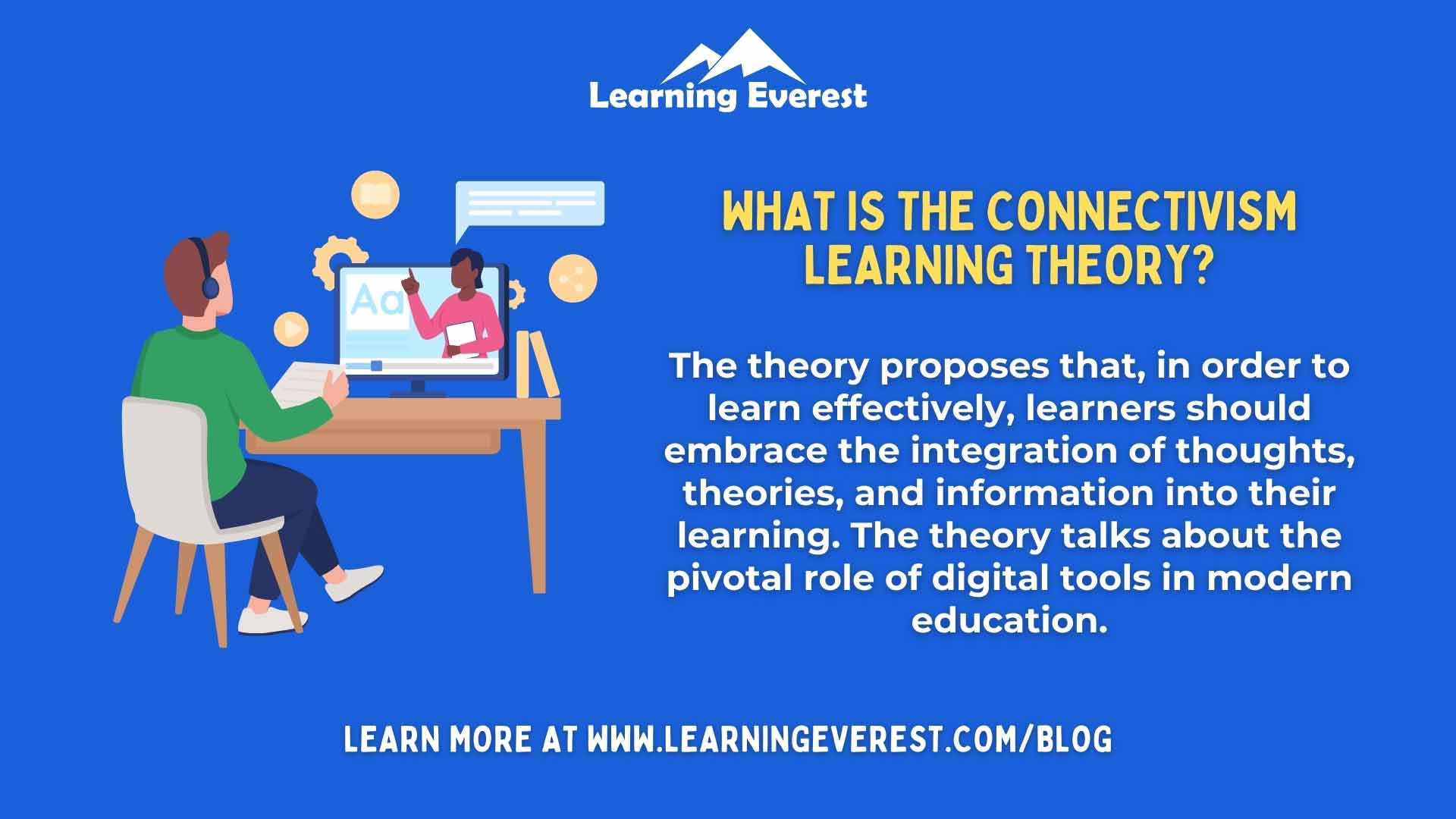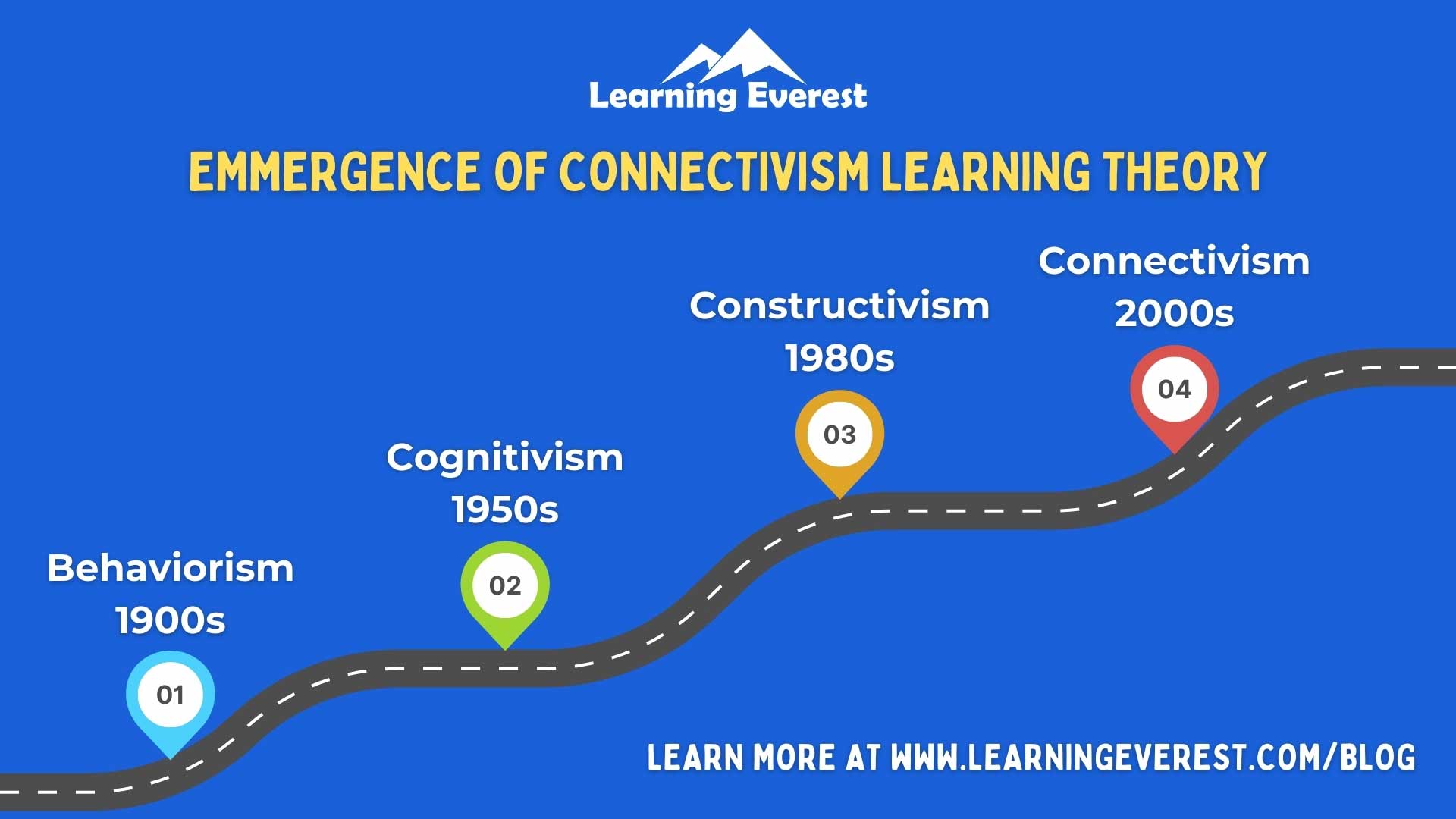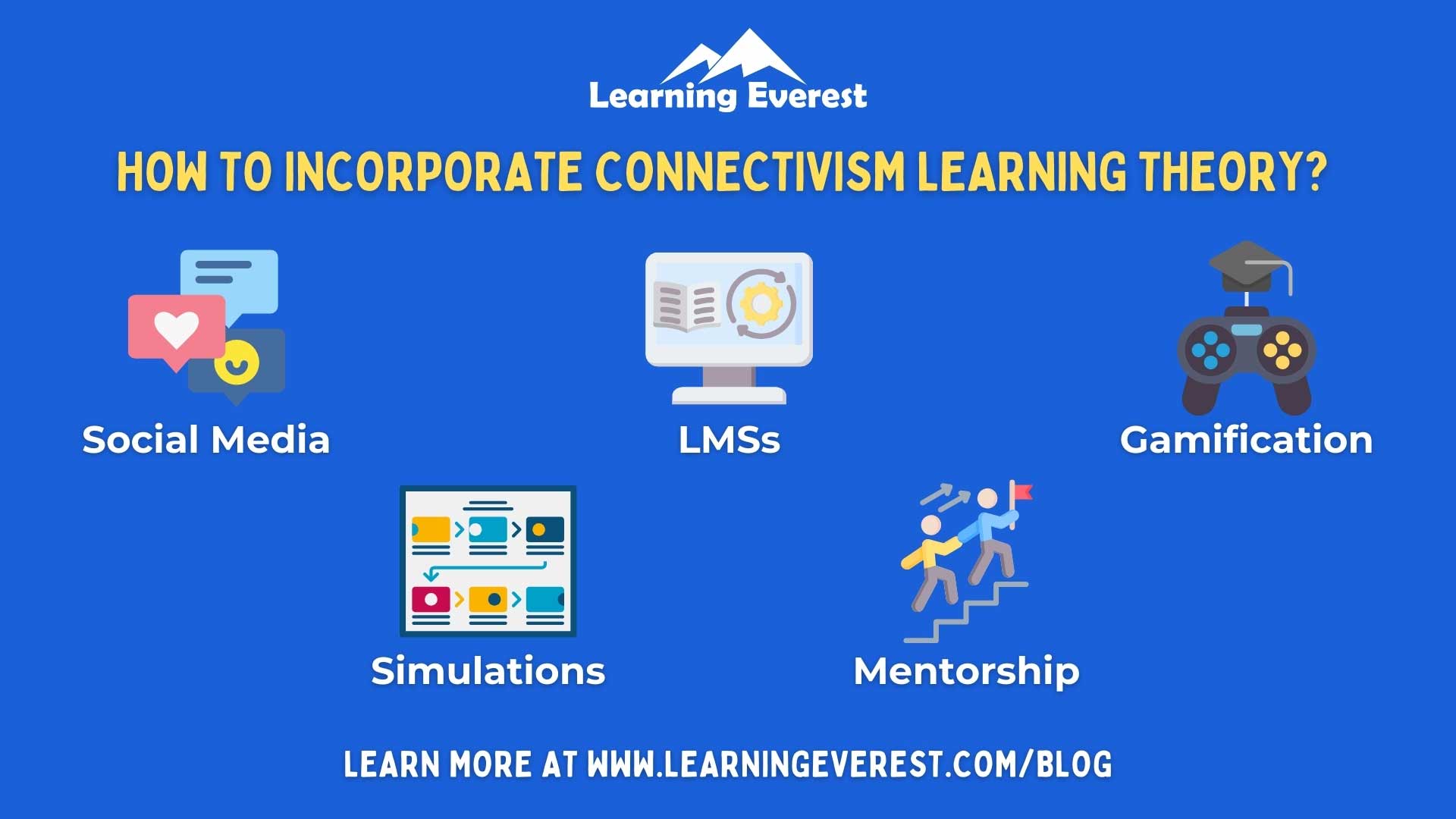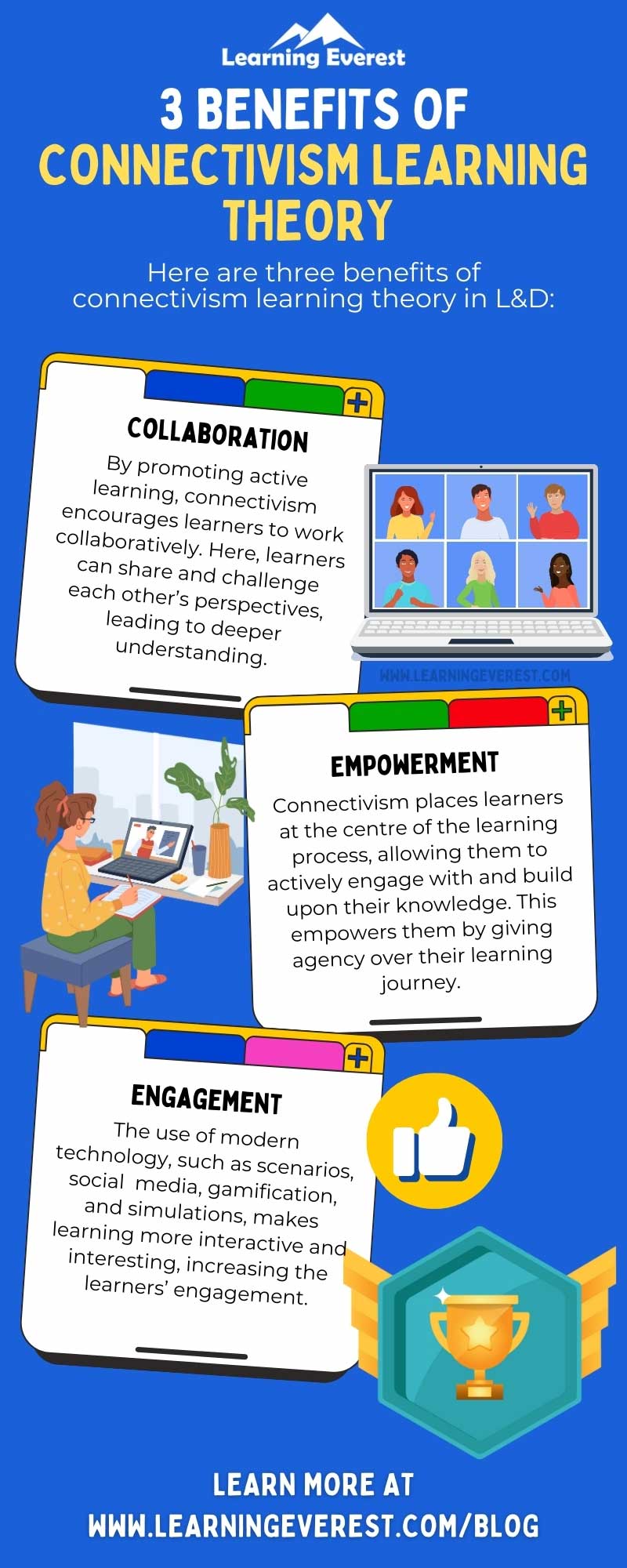What is Connectivism Learning Theory?
The theory proposes that to learn effectively, learners need to integrate thoughts, theories, and information into their learning. The theory speaks to the pivotal role of digital tools in modern education. The theory acknowledges that our constant connectivity gives us the opportunity to make choices about our learning. It also fosters group collaboration and discussion, allowing us to incorporate different perspectives and points of view when making decisions, solving problems, and making sense of information. Connectivist learning takes place outside of the individual mind, in social media, online networks, blogs, information databases, etc.

What is Connectivism Learning Theory?
According to this theory, learning is more than how to build knowledge. Rather, what can be reached in an external network is also considered learning. Nodes and links are often used to describe how information is obtained and connected in a network. Learners are considered “nodes” in the network. A node refers to an object that can be connected to another object, such as a book, a web page, or a person. Connectivist learning is based on the theory that we learn as we create connections or “links” between different “nodes” of information, and we continue to develop and maintain connections to form knowledge.
History of Connectivism Learning Theory
Connectivism was first introduced in 2005 by two theorists, George Siemens and Stephen Downs. They have written two papers on it: Siemens’s paper “Connectivism: Learning as Network Creation” was published in 2004, and Downs’ paper “An Introduction to Connectivism” was published the following year.


The emergence of conjunctive learning theory
These publications addressed the crucial role of technology in the learning process and how the digital age has increased students’ speed of access to information. Since then, both Siemens and Downs have continued to write and speak on the subject, but with slightly different perspectives. Siemens has primarily focused on exploring the social aspects and interactions that underlie the theory, while Downs has delved deeper into the realm of artificial intelligence, looking at how both non-human entities and machine-based tools can facilitate learning.
What are the central principles of connectivist learning theory?
Connectivism builds on established theory and argues that technology is changing what, how, and where we learn. In their research, Siemens and Downs identified eight principles of connectivism. The key principles of connectivism are:
- Learning and knowledge come from diverse opinions.
- Learning is a connecting process.
- Learning can exist in non-human applications.
- The ability to know more is more important than what is currently known.
- To foster continuous learning, the links between nodes need to be nurtured and maintained.
- Being able to see connections between different disciplines, ideas, and concepts is a key skill. You need to learn how to build links that connect point A to point B.
- Accurate and up-to-date information is the goal of all connectivist learning.
- Decision making itself is a learning process.
Connectivism in L&D
Connectivism learning theory presents a modern shift in L&D approaches, setting it apart from the traditional classroom environment. While the main goal of connectivism may be understandable, the real challenge lies in its implementation. Connectivism is characterized by its deep relationship with technology. To truly foster a connectivist learning environment, L&D professionals must effectively integrate digital learning opportunities. This involves incorporating a variety of platforms and tools, from online courses and webinars to social networks and generative AI applications. These can not only accommodate different learning styles, but also provide an economical solution for organizations with limited budgets.
Here are some concrete ways to incorporate connectivist learning theory into L&D.


How to incorporate connectivist learning theory?
Let’s discuss in detail.
1 – Social Media
Social media can enhance traditional corporate learning by providing a wealth of educational resources on social platforms such as LinkedIn, Behance, and Facebook. This fosters global networking and collaborative learning. It opens up discussion opportunities to interested parties beyond the workplace. It allows participants to connect their knowledge to real-world situations and understand the learning process behind these actions through discussions and Q&A sessions. However, the successful use of social media in the workplace requires instructors to ensure digital security and manage distractions.
For more information, read our blog on “What is social facilitation in learning experiences?”
2 – Learning Management System (LMS)
There is no question that online learning is the way of the future. For that, you need an effective mechanism for online training. Learning Management Systems (LMS) are the foundation of online learning. You need an LMS to create and deliver online courses and manage learning programs. An LMS helps learning L&D managers operationalize the entire lifecycle of the learning process in their organizations. Learning management professionals use the LMS to store and distribute courses to employees as needed. Learners take courses and provide feedback using the LMS interface. A good LMS also enables administrators to monitor learner progress, view data analytics, and adjust learning programs for maximum effectiveness.
For more information, read our blog on Moodle LMS: Features and Benefits.
3 – Gamification
Connectivist learning uses gamification as a dynamic tool to capture learners’ innate desire for challenge and reward. By integrating game-like elements, instructors can encourage engagement and foster creative collaboration. For example, leaderboards and achievement badges can motivate learners to dig deeper into a topic, and collaborative games can enhance networking and peer-to-peer learning. However, instructors must strike a balance to ensure that learning is not overshadowed by game mechanics.
To learn more about gamification, read our blog on 5 game mechanics to use in eLearning, which includes gamification examples.
4 – Simulation
Computer simulations can provide immersive learning environments, allowing learners to experiment, make decisions, and observe outcomes in a controlled environment. These simulations help learners think about difficult concepts and abstract ideas in a safe and cost-effective way. An example is a safety training simulation that allows learners to virtually experience a dangerous workplace situation. Fueled by connectivism, such interactive approaches can be customized for each learner, building knowledge networks to deepen their understanding.
The goal of this type of learning is to identify a solution or answer to a real-life problem. Scenario-based learning can be used for compliance training, soft skills training, professional skills training, leadership training, and more. Scenario-based learning environments are great for keeping learners engaged throughout their learning journey. It creates a real-life experience.
To learn more, read our blog on how to integrate scenario-based learning into your customer service training modules.
5 – Mentorship Program
Workplace mentorship programs support connectivism by bringing together employees at different stages of their careers to exchange internal knowledge and discuss case studies, which can inspire other employees to do their jobs better or develop specific skills. Mentors can inspire employees by showcasing success stories within the organization and showing how others have successfully followed a similar development path before. Mentors encourage healthy competition in the workplace. People who work with mentors may notice how well they perform and be motivated to perform at the same or even higher level. This atmosphere motivates everyone to work harder and achieve new goals.
Is there anything you’d like to add? Comment below!
to sum up
Connectivism addresses the major changes taking place in modern L&D programs, tracing the shift from individual to collaborative learning. Connectivism offers valuable insights into modern learning and development programs that incorporate social media and generative AI to connect learners with experts around the world to enrich the learning experience.
Infographic


3 Benefits of Connectivism Learning Theory
Knowledge check!
Frequently Asked Questions (FAQ)
What is Connectivism Learning Theory?
This theory proposes that to learn effectively, learners need to integrate thoughts, theories, and information into their learning. This theory speaks of the pivotal role of digital tools in modern education.
Who developed Concatenative Learning Theory?
Connectivism was first introduced in 2005 by two theorists, George Siemens and Stephen Downs. They have written two papers on it: Siemens’s paper “Connectivism: Learning as Network Creation” was published in 2004, and Downs’ paper “An Introduction to Connectivism” was published the following year.
What is meant by conjunctive learning theory?
To truly foster a connectivist learning environment, L&D professionals must effectively integrate digital learning opportunities, which may involve incorporating a variety of platforms and tools, from online courses and webinars to social networks and generative AI applications.
